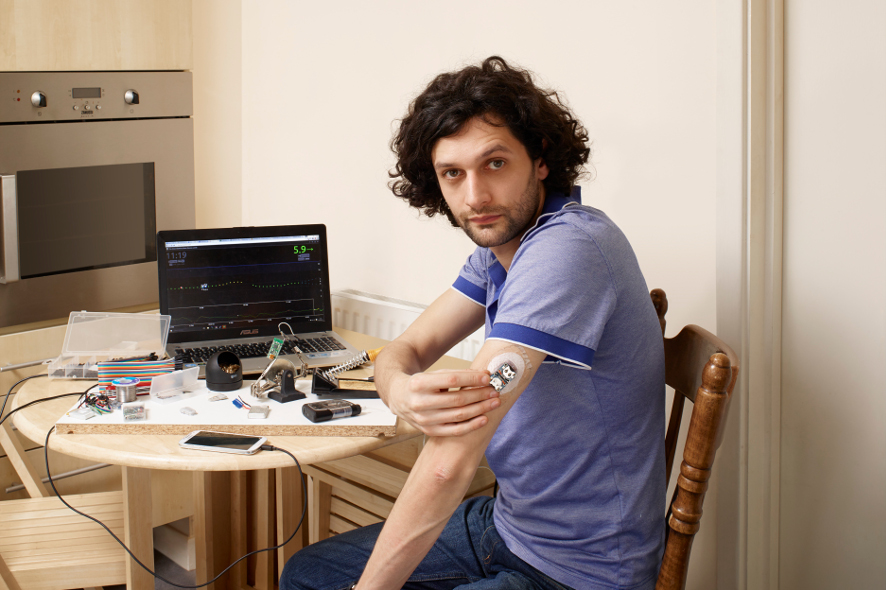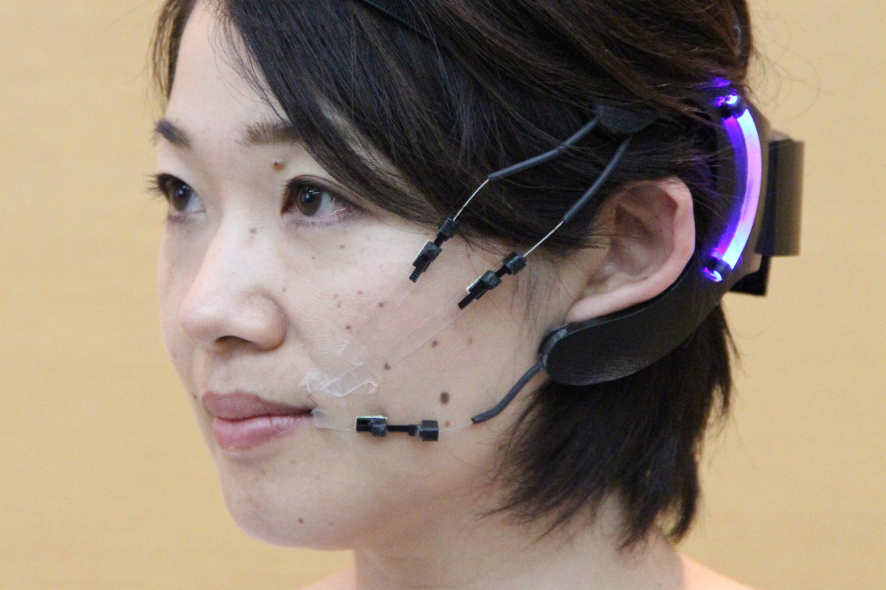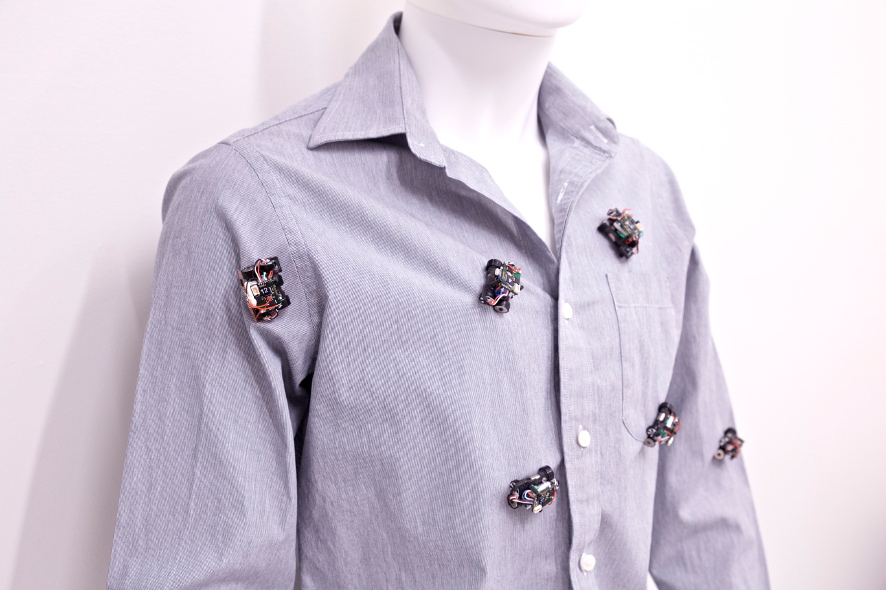On the sidelines of a workshop on wearables at the Ars Electronica Center we talked to Prof. Bernad Batinic.
A research project on wearables is currently underway in your department. It focuses on the use of electronic data gathered by wearables. What exactly are wearables and where are they already being used?
Bernad Batinic: Wearables are wearable technologies normally worn on the body. They facilitate registering, in the form of electronic data, various patterns of human behavior, interaction and experience. Wearables gather physiological data, geo-tracking data, and data about activities in social, athletic and other contexts. The best-known wearables are, no doubt, smartphones and fitness armbands, but there’s a wide array of them! This research project is being funded by the Linz Institute of Technology (LIT).

Timothy Omer has type 1 diabetes an wears a Continuous Glucose Monitoring (CGM) System. An App on his phone collects and aggregates glucose data and suggests medication if necessary. Credit: Timothy Omer
You’re one of the pioneers in the field of electronic data gathering on the internet and online research. Any you’re also director of JKU’s Institute for Pedagogy and Psychology. How are wearables used in your field, and what’s the value for your psychological research—or the value-added—of the data gathered thereby?
Bernad Batinic: We don’t develop new technologies in our field. We use existing technologies such as fitness armbands, smartphones and many other devices on the market to gather data about people. In the social sciences—of which psychology is one field—data has been gathered up to now by means of questionnaires or interviews. Of course, data gathering is an essential part of scholarly research, and this has always entailed a certain degree of inexactitude. Here, we’re opening up a completely new door that leads to a reduction of this imprecision! The idea is to combine questionnaires and interviews with data delivered by wearables and thus achieve better results.
20 years ago, I was more or less the first one in Europe to do online polling. There had already been online polls here and there, but here at JKU I did the pioneering work of expanding and upgrading them to a reliable scientific method of gathering data. At present, a third of all empirical studies are conducted by means of online questionnaires! I have the feeling that, with the use of data from wearables, we’ve reached the next watershed. We’re opening up a completely new chapter.
I’ll give you an example of its application in the field of psychology. If you want to investigate the medical aspects of sleep, there are sleep laboratories. But if you want to look into stress on the part of school children, the quality of their relationship to their parents, and what role sleep plays in this, then, up to now, we’ve asked parents and children a series of questions: Do you sleep well? Do you often wake up in the middle of the night? Do you always go to bed at the same time? Now, this information isn’t all that bad, but subjective falsification is a part of it. With a sensor mat in their beds, the children can be tracked over a week or two, and this data is correlated with their school grades. This provides more precise results.
Another example is research on unemployment. Some observers maintain that the longer a person remains unemployed, the more he/she withdraws socially or the less they take part in social life. Traditionally, research on this is a matter of asking people: Do you go out on weekends? What do you do? How was your week? Naturally, the answers to these questions are subjective and often unconsciously falsified. Now, if you combine data from questionnaires like these with data about the duration of unemployment and simultaneously feed in data about the person’s physical movements around town—on a map of Linz, for example: was the subject actually walking along the Danube, at the municipal swimming pool, or in the pedestrian mall—then you might be able assert with assurance that this person’s activities actually did diminish the longer he/she remained unemployed. This measurement is much more exact.

This wearable robot is originally designed to support the rehabilitation of a hemifacial paralyzed patient. A special smile detection algorithm of facial electromyography signals from the non-affected side of the face, a bio-robotic control is carried out to assist facial expressiveness on the affected side through external manipulations of the facial skin. Credit: Kenji Suzuki
JKU and Ars Electronica have collaborated on many projects over the years. Tomorrow, May 10th, is the start of the conference on data gathering & analysis with wearables, and the opening event is being staged today in cooperation with the Ars Electronica Futurelab. What do you consider the most exciting thing about this collaboration?
Bernad Batinic: We specifically emphasized in our funding application that Ars Electronica was our preferred partner. We regard this as an opportunity to intensify our relationship with Ars Electronica, and I find that holding the opening event here in such a visionary building nicely complements our conference theme. And after all, the Ars Electronica Futurelab has done a lot of research and experiments of its own in this area. The people attending our conference are researchers, many of whom are from elsewhere in Austria as well as Switzerland and Germany. And this was also part of our concept: to let our participants get better acquainted with the Ars Electronica Center’s work.

We envision that future wearable technology will move around the human body, and will react to its host and the environment. To proof this concept, we developed Rovables, miniature robots that can move freely on unmodified clothing. The robots are held in place by magnetic wheels, and can climb vertically. Our applications include on-body sensing, modular displays, tactile feedback and interactive clothing and jewelry. Credit: Artem Dementyev
Do you have in mind a research project that you’d definitely like to work on, one that it might be interesting to implement in cooperation with Ars Electronica?
Bernad Batinic: Yes, there’s one. In fact, I have a lot of ideas! We have so many different sources of data these days. The on-board computer in my car tracks my driving behavior. How stressed did I feel in a particular situation? How often did I exceed the speed limit? At the same time, I wear my fitness armband that measures my pulse. And I have my cell phone, which records how often I contact other people—frequent or infrequent contacts—how long I talk to them, and things like that. We have many devices, all of which produce data. What will make this interesting is the combination of these different data sources. This will be raised to a new level of power! I’m fascinated by the thought of where this is headed!
One thing I’ve long been urged to think about in this connection is visualization of all these data. And I’d love this to be an artistic visualization in conjunction with the Ars Electronica Festival. In the field of psychology, we frequently consider the individual. Imagine equipping 500 people with fitness armbands, or 1,000 or 10,000 people in Austria, and tracking them over the course of a day or a month. Only certain peripheral data such as age, gender, domicile in an urban or rural area, etc. play a role in this. No consideration is given to the data of an individual; only to that of the group. And during this time, there occur certain events that are played up in the media—a politician resigns, there’s a catastrophe in Austria or abroad, and the like. We would be able to measure the course of the state of stress or the state of excitement of our population, and then visualize this.
In this depiction, it should be possible to zoom in, to select and compare groups, and to monitor the stress level or people’s movement activities in reaction to a particular event or at a certain point in time—women vs. men, urban vs. rural, Vienna vs. the rest of the country, and so forth.
Visitors to the Ars Electronica Festival will also be able to experiment on their own. I like the idea of visualizing something for scientific laypeople and giving them the opportunity to understand groups: What’s actually happening here? Imagine a football stadium—I don’t even have to be watching the game; the state of excitement alone tells me how the match is proceeding. It’s what you might call a visualization of the collective psychological state. That would be my idea! Then we’d have a sort of Happiness Index or Satisfaction Index or Stress Index for the entire population.

Prof. Bernad Batinic heads JKU’s Department of Psychology of Work, Organizations and the Media, which was founded in 2005 and is part of the Institute for Pedagogy and Psychology. Batinic earned his master’s degree (1995) in psychology in Gießen, Germany and his Ph.D. (2001) and post-doc (2006) at the University of Erlangen-Nürnberg. He has been a member of JKU’s faculty since 2004. His work focuses on online research and the possibilities of the internet for data-gathering purposes. Already in 1994, he conducted an online poll in the Usenet and, in 1995, published on the internet the first instructions on conducting online polls. He was a founding member of the German Society of Online Research, and is the first scholar in German-speaking Europe to ever conduct a poll online. In the area of the psychology of work and organizational psychology, Bernad Batinic and his team focus their investigations on aspects of gainful employment and well-being.
